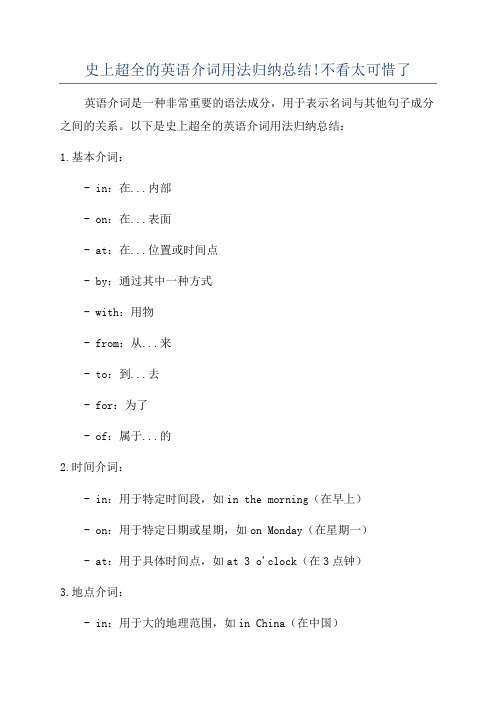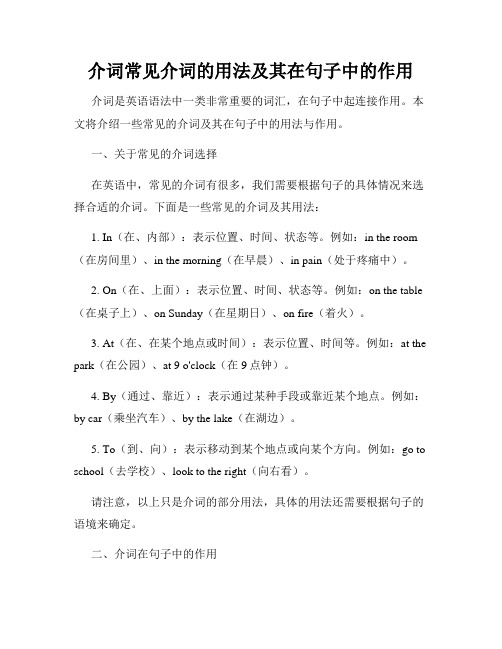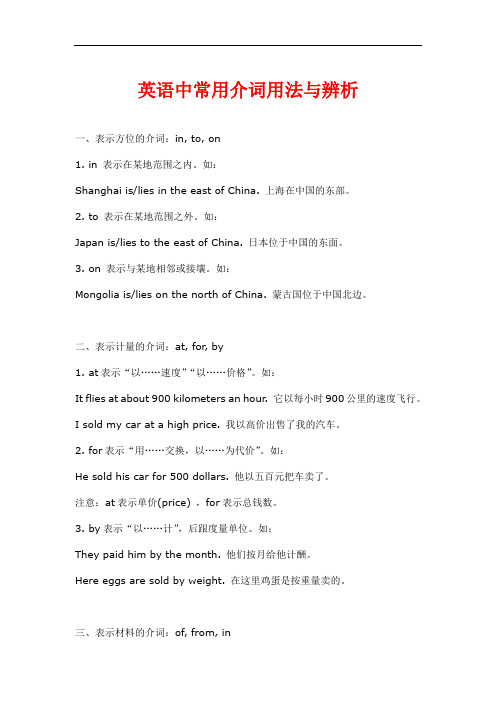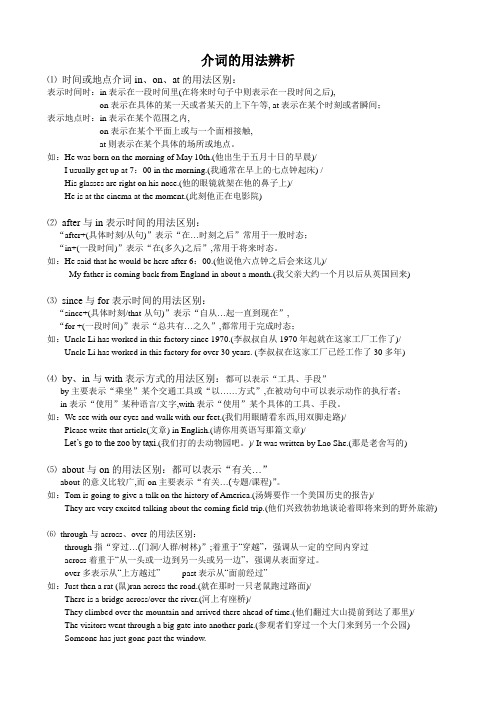常用介词用法及区别整理
介词的用法区别和用法口诀

介词的用法区别和用法口诀一、介词的基本概念和分类介词是英语语法中一种十分重要且常见的词类,用于连接名词、代词或动词与其他句子成分之间的关系。
介词的主要作用是指示名词、代词或动词的位置、方向、时间、方式等。
在句子中,介词常出现在名词短语或从句的开头,并与其后面的成分形成不可分割的整体。
根据其具体功能和用法,介词可以分为以下几类:1. 方位介词:描述事物在空间位置上相对于其他事物的关系。
例如:in(在…里)、on(在…上)、at(在…处)。
2. 时间介词:表示事物发生的时间或持续时间。
例如:in(在…期间)、on (在…时)、at(在…点钟)。
3. 方式介词:表示事物进行活动的方式、手段或方法。
例如:by(通过)、with(用;以;带有)。
4. 原因/目的介词:表示某个行为发生的原因或目标。
例如:for(为了)、because of(因为)。
5. 所属/起源介词:表示某个人或物所属于的组织、地点或来源。
例如:of/from/to(属于/来自/到)。
二、介词的用法区别和常见错误1. in/on/at的用法区别:- in 用于表示在某个大的空间范围内,如城市、国家、房屋等。
例如:in the room(在房间里)、in London(在伦敦)。
- on 用于表示在某个平面或表面上,如桌子、地图等。
例如:on the table (在桌子上)、on the map(在地图上)。
- at 用于表示具体位置或地点,常与动词to be连用。
例如:at the bus stop (在公交车站)、at school(在学校)。
2. by/with的区别:- by 表示通过某种方式或手段进行某个行为。
例如:travel by plane(乘坐飞机旅行)、communicate by email(通过电子邮件交流)。
- with 表示使用某种工具或带有某种特征进行活动。
例如:write with a pen (用钢笔写字)、open the door with a key(用钥匙开门)。
语文中介词的分类和用法

语文中介词的分类和用法语文中介词的分类和用法在学习语文的过程中,介词是一个比较抽象的说法,要用在实际处才能解释清楚介词的具体作用。
下面是小编收集整理的语文中介词的分类和用法,希望大家看完能够有所收获。
一、介词的语法特征(1)表示时间,处所,方式,对象等语法意义。
如:从明天(开始)(表示时间)在家(自修)(表示处所)按原则(办事)(表示方式)把作业(做完)(表示对象)(2)介宾结构主要充当状语,修饰动词或形容词。
如“从车上下来”“比他高”。
有的介宾结构可以作定语,但要加“的”,如“对历史人物的评价”“在桌子上的书”。
少数介宾结构可以充当补语,如“工作到深夜”“睡在床上”。
介宾结构不能做谓语。
(3)“在,向,于,到,给,自”等可以直接附着在动词或其他词语后边,构成一个整体,相当于一个动词。
如“落在我身上”“奔向二十一世纪”“取决于你的'考试成绩”“勇于实践”“走到了目的地”“献给人民”“来自纽约”。
二、介词的分类(1)表示时间,处所:从自自从于打到往在当朝向顺着沿着随着(2)表示方式:按照按照依依照本着经过通过根据以凭(3)表示目的:为、为了、为着(4)表示原因:因、由于、因为(5)表示对象,范围:对、对于、把、向、跟、与、同、给、关于(6)表示排除:除、除了、除去、除非(7)表示被动:被、叫、让、给(8)表示比较:比、和、同上述介词中的“着,了,过”是语素,不是动态助词。
三、介词与动词的区别现代汉语的介词大多数是从古代汉语演变而来的,有些词还兼有介词和动词两种功能。
如“在,为,比,到,给,朝,经过,通过”等。
他为谁为大家。
(动词)我们为人民服务。
(介词)学校的大门朝南。
(动词)学校的大门朝南开着。
(介词)今天我们比技巧。
(动词)你比他强。
(介词)计划通过了。
(动词)通过学习,我们提高了认识。
(介词)二者的区别在于:(1)动词能肯定否定相叠表示疑问,介词不能。
他在不在宿舍(动词)他在黑板上写了几个字。
史上超全的英语介词用法归纳总结!不看太可惜了

史上超全的英语介词用法归纳总结!不看太可惜了英语介词是一种非常重要的语法成分,用于表示名词与其他句子成分之间的关系。
以下是史上超全的英语介词用法归纳总结:1.基本介词:- in:在...内部- on:在...表面- at:在...位置或时间点- by:通过其中一种方式- with:用物- from:从...来- to:到...去- for:为了- of:属于...的2.时间介词:- in:用于特定时间段,如in the morning(在早上)- on:用于特定日期或星期,如on Monday(在星期一)- at:用于具体时间点,如at 3 o'clock(在3点钟)3.地点介词:- in:用于大的地理范围,如in China(在中国)- on:用于较小的地理范围或表面,如on the street(在街上)- at:用于具体地点,如at the supermarket(在超市)4.方向介词:- to:表示到达一些地方,如go to school(去学校)- into:表示进入一些地方,如go into the house(进入房子)- out of:表示离开一些地方,如get out of the car(离开车)5.原因介词:- because of:由于,如He is late because of the traffic(他因为交通堵塞而迟到)- due to:由于,如The flight was canceled due to bad weather(因为恶劣天气,航班被取消)6.动词短语介词:- look after:照顾,如She looks after her younger brother (她照顾她的弟弟)- take care of:照顾,如He takes care of his plants(他照顾他的植物)7.形容词短语介词:- interested in:对...感兴趣,如She is interested in music (她对音乐感兴趣)- good at:擅长...,如He is good at playing basketball(他擅长打篮球)8.其他常见介词用法:- with regard to:关于,如With regard to the matter, I have something to say(关于这件事,我有些话要说)- instead of:代替,如I will go instead of him(我将代替他去)- according to:根据,如According to the weather forecast, it will rain tomorrow(根据天气预报,明天会下雨)以上是一些常见的英语介词用法总结,希望能帮到你!。
介词常见介词的用法及其在句子中的作用

介词常见介词的用法及其在句子中的作用介词是英语语法中一类非常重要的词汇,在句子中起连接作用。
本文将介绍一些常见的介词及其在句子中的用法与作用。
一、关于常见的介词选择在英语中,常见的介词有很多,我们需要根据句子的具体情况来选择合适的介词。
下面是一些常见的介词及其用法:1. In(在、内部):表示位置、时间、状态等。
例如:in the room (在房间里)、in the morning(在早晨)、in pain(处于疼痛中)。
2. On(在、上面):表示位置、时间、状态等。
例如:on the table (在桌子上)、on Sunday(在星期日)、on fire(着火)。
3. At(在、在某个地点或时间):表示位置、时间等。
例如:at the park(在公园)、at 9 o'clock(在9点钟)。
4. By(通过、靠近):表示通过某种手段或靠近某个地点。
例如:by car(乘坐汽车)、by the lake(在湖边)。
5. To(到、向):表示移动到某个地点或向某个方向。
例如:go to school(去学校)、look to the right(向右看)。
请注意,以上只是介词的部分用法,具体的用法还需要根据句子的语境来确定。
二、介词在句子中的作用介词在句子中起到连接的作用,连接名词、动词、形容词等与其他成分之间的关系。
下面将介绍介词在句子中常见的几种用法:1. 表示位置关系:例如,在句子“The book is on the table.”中,介词on表示书放在桌子上。
2. 表示时间关系:例如,在句子“I have a meeting at 9 o'clock.”中,介词at表示在9点钟有一个会议。
3. 表示方式或手段:例如,在句子“He solved the problem by himself.”中,介词by表示他自己通过/用自己的方式解决了问题。
4. 表示目的或用途:例如,在句子“She bought some flowers for her mother.”中,介词for表示她为她的母亲买了些花。
英语中常用介词用法与辨析

英语中常用介词用法与辨析一、表示方位的介词:in, to, on1. in 表示在某地范围之内。
如:Shanghai is/lies in the east of China. 上海在中国的东部。
2. to 表示在某地范围之外。
如:Japan is/lies to the east of China. 日本位于中国的东面。
3. on 表示与某地相邻或接壤。
如:Mongolia is/lies on the north of China. 蒙古国位于中国北边。
二、表示计量的介词:at, for, by1. at表示“以……速度”“以……价格”。
如:It flies at about 900 kilometers an hour. 它以每小时900公里的速度飞行。
I sold my car at a high price. 我以高价出售了我的汽车。
2. for表示“用……交换,以……为代价”。
如:He sold his car for 500 dollars. 他以五百元把车卖了。
注意:at表示单价(price) ,for表示总钱数。
3. by表示“以……计”,后跟度量单位。
如:They paid him by the month. 他们按月给他计酬。
Here eggs are sold by weight. 在这里鸡蛋是按重量卖的。
三、表示材料的介词:of, from, in1. of成品仍可看出原料。
如:This box is made of paper. 这个盒子是纸做的。
2. from成品已看不出原料。
如:Wine is made from grapes. 葡萄酒是葡萄酿成的。
3. in表示用某种材料或语言。
如:Please fill in the form in pencil first. 请先用铅笔填写这个表格。
They talk in English. 他们用英语交谈。
注意:in指用材料,不用冠词;而with指用工具,要用冠词。
常用介词的用法辨析(整理版)

介词的用法辨析⑴时间或地点介词in、on、at的用法区别:表示时间时:in表示在一段时间里(在将来时句子中则表示在一段时间之后),on表示在具体的某一天或者某天的上下午等, at表示在某个时刻或者瞬间;表示地点时:in表示在某个范围之内,on表示在某个平面上或与一个面相接触,at则表示在某个具体的场所或地点。
如:He was born on the morning of May 10th.(他出生于五月十日的早晨)/I usually get up at 7:00 in the morning.(我通常在早上的七点钟起床) /His glasses are right on his nose.(他的眼镜就架在他的鼻子上)/He is at the cinema at the moment.(此刻他正在电影院)⑵after与in表示时间的用法区别:“after+(具体时刻/从句)”表示“在…时刻之后”常用于一般时态;“in+(一段时间)”表示“在(多久)之后”,常用于将来时态。
如:He said that he would be here after 6:00.(他说他六点钟之后会来这儿)/My father is coming back from England in about a month.(我父亲大约一个月以后从英国回来)⑶since与for表示时间的用法区别:“since+(具体时刻/that-从句)”表示“自从…起一直到现在”,“for +(一段时间)”表示“总共有…之久”,都常用于完成时态;如:Uncle Li has worked in this factory since 1970.(李叔叔自从1970年起就在这家工厂工作了)/ Uncle Li has worked in this factory for over 30 years. (李叔叔在这家工厂已经工作了30多年)⑷by、in与with表示方式的用法区别:都可以表示“工具、手段”by主要表示“乘坐”某个交通工具或“以……方式”,在被动句中可以表示动作的执行者;in表示“使用”某种语言/文字,with表示“使用”某个具体的工具、手段。
(完整word版)介词用法归纳,推荐文档
介词(preposition)又称前置词,是一种虚词。
介词不能单独做句子成分。
介词后须接宾语,介词与其宾语构成介词短语。
一、介词从其构成来看可以分为:1、简单介词(Simple prepositions)如:at ,by, for, in, from, since, through等;2、复合介词(Compound prepositions)如:onto, out of, without, towards等;3、短语介词(phrasal prepositions)如;because of, instead of, on account of, in spite of, in front of等;4、二重介词(double prepositions)如:from behind, from under, till after等;5、分词介词(participial prepositions),又可称动词介词(verbal prepositions)如:during, concerning, excepting, considering, past等。
二、常见介词的基本用法1、 about 关于Do you know something about Tom?What about this coat?(……怎么样)2、 after 在……之后I’m going to see you after supper. Tom looked after his sick mother yesterday.(照看)3、 across 横过Can you swim across the river.4、 against 反对Are you for or against me?Nothing could make me turn against my country.(背叛)5、 along 沿着We walked along the river bank.6、 before 在……之前I hope to get there before seven o’clock. It looks as though it will snow before long.(不久)7、behind 在……后面The sun is hidden behind the clouds.8、by 到……时We had learned ten English songs by the end of last term.9、during 在……期间Where are you going during the holiday. 10、except 除了Everyone except you answered the question correctly.11、for 为了The students are studying hard for the people.12、from 从I come from Shanghai.13、in 在……里 on 在……上面 under在……下面There are two balls in/on/under the desk.14、near 在……附近We live near the park.15、of ……的Do you know the name of the winner.16、over 在……正上方There is a bridge over the river.Tom goes over his English every day.(复习)17、round/around 围绕The students stand around the teacher.18、to 朝……方向Can you tell me the way to the cinema.19、towards朝着The car is traveling towards Beijing.20、with 和……一起me?Would you like to go to the cinema with学习这些介词时可以先记住它的汉语意思,然后参照例句来加深理解,并在今后的学习中加以灵活运用。
常用介词用法及区别整理
1、表示时间得介词(1)at:用于表示时刻,时间得某一点,年龄,就餐时间at noon在午时at night在夜间at present目前(2)on:用于星期几,某天,某一天得上午、下午、晚上(指具体得某一天时,一律用,也可以说就是上午、下午、晚上有修饰得一律用ON),特定得时间、含day得节日on Sunday 在星期天on Sunday morning 在星期天得上午on March 8 在3月8日(3)in:用于表示周、月、季节、年、泛指上午、下午、晚上。
in 1999 在1999年in November 在11月份in summer 在夏季in the afternoon在下午in + 时间段:过……后(内),用于将来时I think he will be back in an hour、我想她一小时后就会回来。
I heard that she woul d be back in a month、我听说她一个月后回来得。
(4)after:在……之后after that ,no one should ever kill a seagull 、从那时起,任何人不得捕杀海鸥。
after + 时间段:在……之后,用于过去时。
(5)before:在……之前Wei hua got up before 7 o’cl ock this morning 、今天早晨,魏华在7点之前起床了。
He won’t come back before five、(6)by:到……为止,截止(到)……By the time i arrived ,she had already gone 、在我到达之前,她已经走了。
The work must be finished by Friday、We had three meetings by last Friday、(7)for:达……之久(表示过了多少时间),可以与一般现在时,过去时,将来时连用,但就是经常与完成时连用。
各大介词知识点总结
各大介词知识点总结一、介词的定义和作用介词是连接名词、代词或动词等成分的一种虚词,用来表示名词、代词等在时间、空间、原因、方向等方面的关系。
介词通常放在名词、代词或动词的前面,起连接作用。
常见的介词有in, on, at, by, for, with, to, from, during, until等。
二、介词的分类1. 时间介词时间介词用来表示动作、状态发生的时间,常见的时间介词有in, on, at等。
其中in用来表示年、月、季节、一天内的特定时间,如in 1998, in April, in spring, in the morning等;on用来表示某天、某日、某个日期、某个节日、星期几、某个特定的时刻,如on Monday, on May 1st, on Christmas Day, on 7 o'clock等;at用来表示钟点、节日、特定的时刻、某个时期,如at 8 o'clock, at Christmas, at the moment等。
2. 地点介词地点介词用来表示名词、代词所处的地点或者方位,常见的地点介词有in, on, at, under, over, above, below, behind, in front of等。
其中in表示在某个范围内,如in the room, in China;on表示在某个平面或位置上,如on the table, on the wall;at表示在某个点或者位置,如at the bus stop, at the cinema;under表示在某个物体的下面,over表示在某个物体的上面,above表示在某物体的上方,below表示在某物体的下方,behind表示在某物体的后面,in front of表示在某物体的前面。
3. 方向介词方向介词用来表示名词或代词的方向,常见的方向介词有to, from, into, out of, towards, across等。
介词的用法区分规则和用法总结
介词的用法区分规则和用法总结一、介词的基本概念介词是连接名词或代词与其他词组成一个短语,在句子中起到表示位置、时间、原因、条件、目的等作用。
介词通常位于名词或代词之前,用来修饰或限定其意义。
二、介词的分类1. 时间和空间关系在时间和空间方面,介词可以表示地点、方向、目标以及时间的关系。
常见的有in, on, at, to, from等。
- In表示大范围内部,如in the room(在房间里),in the garden(在花园里)。
- On表示表面接触上,如on the table(在桌子上),on the wall(在墙壁上)。
- At表示具体位置上,如at the bus stop(在公交车站),at the park entrance(在公园入口)。
- To表示运动朝向,如go to school(去学校),come to my house(来我家)。
- From表示出发点或来源,如come from Canada(来自加拿大),fly from London to Paris(从伦敦飞往巴黎)。
2. 原因和方式关系介词也可以表示某个动作的原因和方式。
常见的有for, with, by等。
- For表示目的或原因,如study for the exam(为考试学习),thank you foryour help(感谢你的帮助)。
- With表示伴随或具备某种条件,如play with friends(和朋友一起玩),a man with glasses(戴眼镜的人)。
- By表示手段或方式,如by bus(乘公交车),by email(通过邮件)。
3. 关系和比较介词还可以表示两个事物之间的关系和比较。
常见的有of, in, between等。
- Of表示所属关系,如a friend of mine(我的一个朋友),the color of the sky (天空的颜色)。
- In表示位置或状态,在....之中。
- 1、下载文档前请自行甄别文档内容的完整性,平台不提供额外的编辑、内容补充、找答案等附加服务。
- 2、"仅部分预览"的文档,不可在线预览部分如存在完整性等问题,可反馈申请退款(可完整预览的文档不适用该条件!)。
- 3、如文档侵犯您的权益,请联系客服反馈,我们会尽快为您处理(人工客服工作时间:9:00-18:30)。
1、表示时间的介词(1)at:用于表示时刻,时间的某一点,年龄,就餐时间at noon在午时at night在夜间at present目前(2)on:用于星期几,某天,某一天的上午、下午、晚上(指具体的某一天时,一律用,也可以说是上午、下午、晚上有修饰的一律用ON),特定的时间、含day的节日on Sunday 在星期天on Sunday morning 在星期天的上午on March 8 在3月8日(3)in:用于表示周、月、季节、年、泛指上午、下午、晚上。
in 1999 在1999年in November 在11月份in summer 在夏季in the afternoon在下午in + 时间段:过……后(内),用于将来时I think he will be back in an hour.我想他一小时后就会回来。
I heard that she would be back in a month.我听说她一个月后回来的。
(4)after:在……之后after that ,no one should ever kill a seagull .从那时起,任何人不得捕杀海鸥。
after + 时间段:在……之后,用于过去时。
.(5)before:在……之前Wei hua got up before 7 o’cl ock this morning .今天早晨,魏华在7点之前起床了。
He won’t come back before five.(6)by:到……为止,截止(到)……By the time i arrived ,she had already gone .在我到达之前,她已经走了。
The work must be finished by Friday.We had three meetings by last Friday.(7)for:达……之久(表示过了多少时间),可以和一般现在时,过去时,将来时连用,但是经常和完成时连用。
Florence often worked for twenty-four hours without rest .弗洛沦斯常常工作24小时而不休息。
(8)since:自……以来(表示从以前某时直到现在仍在继续)Since + 时间段+ ago Array Since + 时间点Since +Since that time ,my eyes had never been very good.从那时起,我的眼睛一直不是很好。
(9)during:在……期间During the lifetime of one man , north America andEurope will more further apart by nearly two meters ..在一个人的一生期间,北美洲和欧洲由于漂移,其间的距离将要增加差不多两米。
(10)through:一直……(从开始到结束)He ,who l ed the united states through these years ,was shot on April 14, 1865 ,at a theater in Washington领导美国度过了这些年代的他,于1865年4月14日在美国华盛顿一家戏院里被人枪杀。
(11)from:从……起(时间)the workers were made to work from 7 in the morning to 7 in the evening .工人们被迫从早7点工作到晚7点。
From…to…:从一点时间到另一点时间。
(12)within:不……超过的范围he will arrive within an hour .他一小时内就人到。
(13)until/till: 用于某动作或状态延续到某一时间终止。
Until可用于句首,而till不用于句首。
不可延续则用not…until Alice didn’t go to bed until 11 p.m. last night.Wait here until the rain stops.Don’t get off the bus until it stops.2、表示地点的介词(1)at:在某地点(表示比较狭窄的场所)at school上学at home在家.at 320 Xinfu district 在新抚区320号at the station 在火车站(2)in:在某地(表示比较宽敞的场所)she will arrive in shanghai at ten .10点她将到达上海。
(3)表示地点方向的on ,und er ,over ,above ,bel ow①on:在……上面,有接触面on the tabl e 在桌子上面②above:在……上方sometimes Juliana could hear planes above the trees.有时朱莉安娜能听到树林上空的飞机声。
③over:在……正上方,是under的反义词over these tombs ,they built pyramids .在这些坟墓上,他们建起了金字塔。
④under:在……下面,在……之内the twin sisters put the basket under the tree .这姐俩把篮子放到了树下。
⑤below:在……下方,(不一定是正下方)three thousand meters below her ,she coul d see nothing except the thick jungle .3000米以下,除了茂密的丛林之外,她什么也看不见。
(4)near ,by①near:近的,不远的(=not far)是far的反义词,near还可以指时间,in the near future在不远的将来。
.G reen’s lake w as a small lake near his home .格林湖是他家附近的一个小湖。
②by:在……旁边,比near的距离要近Juliana walked by the sid e of the river for six more l ong days .朱莉安娜沿着河岸又走了足足6天。
(5)between ,among ,around①between:在两者之间The differences between American English and British English are not very great .美国英语和英国英语之间的差别不是很大。
②among:在三者或者更多的之中there are some American students among us .在我们中间有几个美国学校。
③around:环绕,在…..的周围,在……的四周they arrived at a valley with high mountains all around it .他们到达了四周有高山环绕的山谷(6)in front of ,behind(互为反义词)①in front of :在……的前面there is a car in front of the house .房子前面有一辆小汽车。
②behind :在…..后边are there any cows behind the house ?房子后面有一些牛吗?.(7)in ,into ,out of①in:在…..之内,用于表示静止的位置there are four girls in the room.房间里有4个女孩。
②into:进入,用于表示有特定终点的运动方向,通常用于表示动作的动作之后。
如:come ,go ,walk ,jump ,run..she took me from the hall into my classroom .她把我从门厅带进我的教室里边去。
(8)al ong ,across ,through①al ong:沿着go along Zhongshan road and turn right at the second crossing .沿着中山路走然后在第二个十这路口向右拐。
②across:横过(平面物体)very slowly,the continents are moving across the face of the world .各个洲在地球表面缓缓漂移。
③through:贯通,通过the students walked through the gate with uncle Wang .学生们随着王叔叔通过大门。
(9)to ,for ,from①to:到达……地点(目的地)或方向where’s jack? he has gone to London.杰克上哪了?他去伦敦了。
②for:表示目的,为了…….do you know what he comes here for ? 你知道他为什么来这儿吗?③from:从……地点起how far is it from London to new york? 从伦敦到纽约有多远?3、介词的用法区别⑴时间或地点介词in、on、at的用法区别:表示时间时, in表示在一段时间里(在将来时句子中则表示在一段时间之后), on表示在具体的某一天或者某天的上下午等, at表示在某个时刻或者瞬间;表示地点时, in表示在某个范围之内, on表示在某个平面上或与一个面相接触,at则表示在某个具体的场所或地点。
如:He was born on the morning of May 10th.(他出生于五月十日的早晨)I usually get up at 7:00 in the morning.(我通常在早上的七点钟起床)His glasses are right on his nose.(他的眼镜就架在他的鼻子上)He is at the cinema at the moment.(此刻他正在电影院)⑵after与in表示时间的用法区别:“after+(具体时刻/从句)”表示“在…时刻之后”常用于一般.时态;“in+(一段时间)”表示“在(多久) 之后”,常用于将来时态。
如:He said that he would be here after 6:00.(他说他六点钟之后会来这儿)My father is coming back from England in about a month.(我父亲大约一个月以后从英国回来)⑶since与for表示时间的用法区别:“since+(具体时刻/that-从句)”表示“自从…起一直到现在”,“for +(一段时间)”表示“总共有…之久”,都常用于完成时态;如:Uncle Li has worked in this factory since 1970.(李叔叔自从1970年起就在这家工厂工作了)Uncle Li has worked in this factory for over 30 years. (李叔叔在这家工厂已经工作了30多年)⑷by、in与with表示方式的用法区别:都可以表示“工具、手段”,但是by主要表示“乘坐”某个交通工具或“以……方式”,在被动句中可以表示动作的执行者;in 表示“使用”某种语言/文字,with表示“使用”某个具体的工具、手段。
